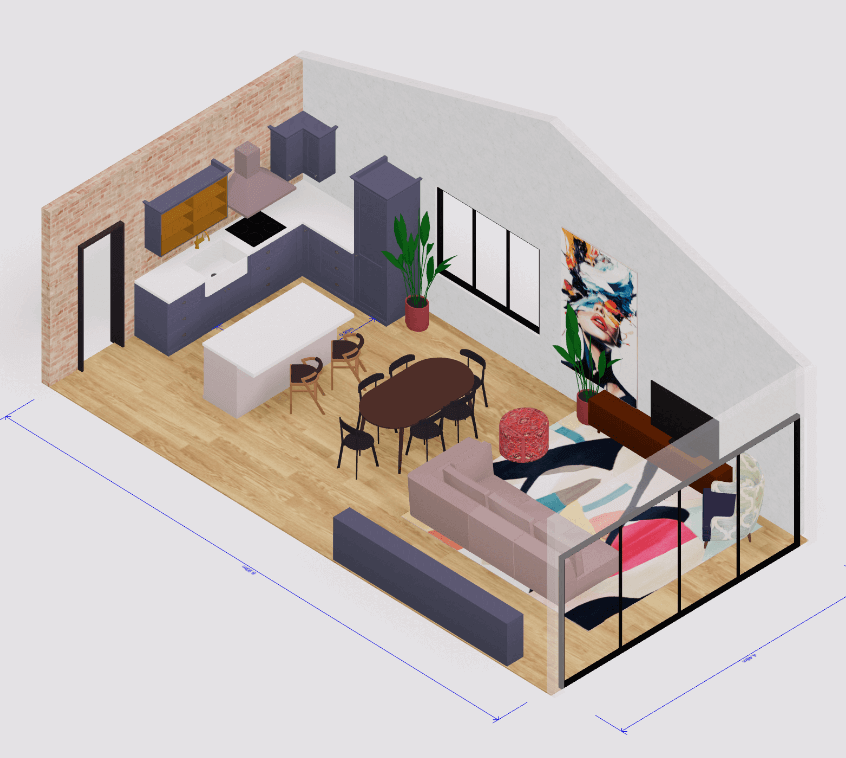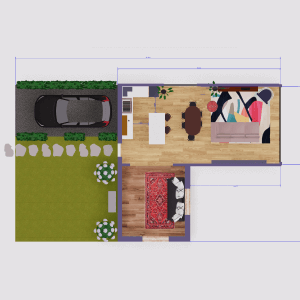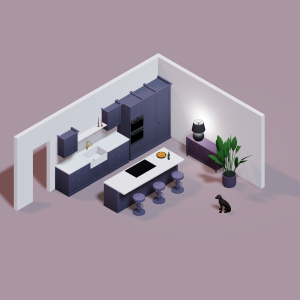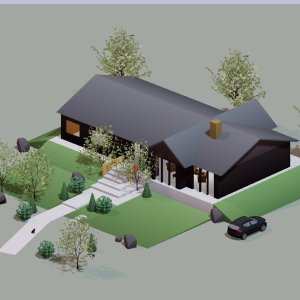3D home modeling software revolutionizes real estate marketing strategies. Real estate professionals utilize software such as SketchUp and AutoCAD to create immersive property visualizations. These tools enable agents to provide virtual tours, enhancing client engagement significantly. Data from the National Association of Realtors indicates virtual tours can increase listing views by over 40%, making properties more likely to sell quickly.
SketchUp offers ease of use with extensive model libraries, beneficial for quick conceptual designs. AutoCAD excels in precision and detailed architectural plans, preferred by professionals for complex projects. Both applications support increased sales effectiveness by allowing potential buyers to visualize properties in great detail before visiting.
In efficiency, SketchUp outperforms many competitors due to its intuitive interface and extensive plugin library. AutoCAD, on the other hand, leads in architectural detail and technical drawings, essential for construction and permits. For real estate professionals, time saved in creating presentations directly correlates with more opportunities for client interaction and sales.
Arcadium 3D is a unique solution tailored for non-complex and fast idea-to-result software. Arcadium 3D is browser-based. The designs can be shared via a link. This 3D modeling software enables users to create 3D house plans in minutes. Its simplicity and uncomplicated nature make it an excellent tool for real estate professionals seeking to enhance their marketing materials with interior design proposals, complementing more technical tools like SketchUp and AutoCAD.
Contents:
Key Features of Top 3D Home Modeling Software
What sets apart the leading 3D home modeling software in functionality? Interactive walkthroughs stand out. These allow potential buyers to virtually navigate through properties, making every corner and detail accessible. Virtual staging solutions transform empty spaces into furnished, decorated rooms, giving clients a glimpse of potential. Enhanced lighting features simulate different times of the day, showcasing properties in various lighting conditions, illustrating versatility.
Why is customization considered a crucial element? Personalization options empower real estate professionals. Users can modify textures, colors, and materials, tailoring each model to client preferences. Landscape tools enable the addition of outdoor features like gardens, pools, and patios, making exteriors as appealing as interiors. Customizable lighting tools offer the ability to create specific moods or highlight architectural details, ensuring properties are shown in their best light.
How do collaboration tools enhance the software’s utility? Real-time collaboration bridges geographical divides. Teams can work simultaneously on projects, share updates, and make decisions collectively, streamlining workflows. Cloud storage solutions facilitate easy access to models from any location, ensuring flexibility. Feedback mechanisms allow for the incorporation of suggestions or changes directly into the model, optimizing the design process.
In the arena of 3D home modeling software, the depth of features distinguishes premier platforms from basic ones. Enhanced customization options allow for more precise tailoring to client needs than simpler, less versatile tools. Advanced collaboration functions streamline project completion more efficiently than software lacking in real-time communication capabilities. Thus, professionals equipped with comprehensive tools can anticipate not just meeting but exceeding client expectations, establishing a significant edge in the competitive real estate market.
Choosing the Best Software for Virtual Staging
What criteria should be prioritized when selecting software for virtual staging? Ease of use stands paramount. Software applications featuring intuitive interfaces allow real estate professionals to create realistic models without extensive training. Tools with drag-and-drop functionality, straightforward navigation, and comprehensive tutorials support quick learning curves, enabling users to generate detailed home visualizations efficiently.
How crucial is realism in virtual staging software? Utmost importance is placed on this aspect. Programs that offer a wide array of textures, furniture models, and lighting options empower users to design spaces that closely mimic reality. These features help in creating immersive experiences, allowing potential buyers to envision living in the homes. High-quality rendering capabilities ensure that shadows, reflections, and textures simulate real-world conditions, enhancing the overall visual appeal.
Does software flexibility affect the staging process? Significantly, flexibility facilitates customization and scalability. Solutions that support various architectural styles, from contemporary apartments to rustic houses, provide users with the versatility needed to cater to diverse client preferences. Platforms that allow modifications and adjustments to designs at any stage offer the adaptability necessary to refine presentations and meet clients' specific needs.
In evaluating software for virtual staging, performance efficiency outshines mere aesthetic offerings. Platforms that render scenes swiftly enable faster project completions than those with lengthy processing times, streamlining the workflow for real estate professionals. Further, solutions with extensive libraries of decor items and materials reduce the need for external resources, offering a more comprehensive toolset for crafting engaging virtual spaces. This comprehensive approach ensures that the chosen software meets both the creative and practical demands of virtual staging, making the selection well-suited for dynamic real estate visualization requirements.
Benefits of 3D Modeling in Real Estate Marketing
Why does 3D modeling stand out in real estate marketing? It transforms static images into interactive experiences. Clients engage with properties through virtual tours, exploring rooms, layouts, and design features with ease. This immersive interaction increases client interest and investment in the property.
How does 3D modeling enhance advertisement materials? By providing lifelike representations of properties. Brochures and websites come alive with 3D renderings, offering perspectives that photographs cannot. These visualizations help clients visualize themselves in the space, thereby strengthening their emotional connection to the property.
What role does 3D modeling play in pre-construction sales? It acts as a powerful tool for showcasing properties before they are built. Investors and buyers get a clear understanding of the project, including dimensions, textures, and spatial arrangements, which reduces uncertainty and boosts confidence in their investment decisions.
In terms of effectiveness, 3D modeling outperforms traditional marketing techniques in several key areas. Engagement levels with interactive 3D tours significantly surpass those of static images, leading to longer viewing times and higher conversion rates. Visual accuracy in 3D renderings helps in reducing misunderstandings and misinterpretations of property layouts, which often occur with conventional floor plans and descriptions. The ability to visualize modifications and customizations in real-time fosters a more personalized buying experience, distinguishing 3D modeling as a superior tool for real estate professionals aiming to captivate and convert potential clients.
Integration with Virtual Reality for Property Tours
How does integration with virtual reality enhance property tours? It transforms static images into immersive experiences. Users navigate spaces as if they were physically present, moving from room to room with ease. Details such as textures, lighting, and spatial relationships become vivid, allowing for a deeper understanding of the property's layout and potential.
Why is this integration a game-changer for real estate professionals? It shortens the sales cycle. Prospects gain a comprehensive view of properties without the need for physical visits, saving time for both agents and clients. Moreover, this technology enables the showcasing of yet-to-be-constructed properties, offering a glimpse into future developments through detailed, lifelike simulations.
What benefits do clients experience with virtual reality tours? They enjoy unparalleled convenience and insight. Decision-making becomes informed, as clients assess properties from the comfort of their homes, comparing features such as room sizes, design options, and finishes without the need to travel. This accessibility broadens the market reach, attracting buyers from distant locations who can now explore properties remotely.
Virtual reality tours provide a richer, more engaging experience than traditional photo galleries or video tours, showcasing properties in unparalleled detail and from every angle. This interactive approach not only captivates potential buyers' attention longer but also increases their emotional connection to the property, significantly enhancing the likelihood of a sale. Through the lens of virtual reality, the perception of space, design, and potential becomes clearer, establishing a new standard for property tours in the real estate industry.
Cost-Effectiveness of Digital Home Modeling Solutions
How does the affordability of 3D home modeling software stack up against traditional home staging methods? Significantly better, most would argue. Professionals save on the expenses associated with physical staging, such as furniture rentals and staging consultations. Digital models eliminate the need for transport, setup, and storage of physical items, slashing overhead costs dramatically.
What about the return on investment with these digital solutions? Impressively high. Real estate agents and developers witness faster sales cycles and increased interest from potential buyers through engaging virtual tours. Enhanced visualizations translate into quicker decision-making by buyers, often willing to pay a premium for properties they've explored virtually.
Can the long-term benefits justify the initial outlay for software licensing? Absolutely. Beyond the immediate cost savings and sales benefits, the software offers scalable solutions. Firms can reuse and adapt existing digital models for new projects, spreading the cost over numerous ventures. This flexibility reduces future expenses as the need for new physical staging diminishes over time.
In terms of cost-efficiency, digital home modeling solutions outshine manual staging and physical model creation in nearly every aspect. They demand fewer resources for maintenance and can be updated or modified at minimal cost. These digital platforms often come with extensive libraries of furniture and decor options, saving users from the costly process of acquiring and updating physical staging assets.
User-Friendly Interfaces for Quick Learning
Why do some professionals hesitate to adopt new technology? Often, it's the perceived steep learning curve. 3D home modeling software breaks this barrier with user-friendly interfaces designed for quick mastery. Tools, menus, and features are logically organized, simplifying navigation for users. Tutorials, support forums, and inline help options educate users, enhancing their learning experience.
How does this software facilitate rapid proficiency? By integrating intuitive drag-and-drop functionalities and pre-designed templates, among others. These elements reduce the time needed for initial training. Users can start basic modeling within minutes, advancing to more complex structures as they grow more comfortable. The software's design encourages experimentation, allowing users to learn from direct interaction.
What makes these interfaces stand out for real estate professionals? The specific needs of the real estate industry are considered in the development of these platforms. Users can create realistic models of properties, including interior designs and landscaping options. This capability enables professionals to present virtual tours and detailed representations of properties to potential buyers, increasing engagement and interest.
For real estate professionals, 3D home modeling software with user-friendly interfaces stands as a significant advantage. Traditional methods of property presentation often involve physical models or flat images, which limit the viewer's ability to fully envision the space. In contrast, 3D modeling software offers a dynamic and immersive experience. This not only aids in quicker learning for the professionals but also translates into more compelling presentations for clients, ultimately facilitating more successful transactions.
Expanding Portfolio with 3D Rendered Images
Why do real estate professionals turn to 3D home modeling software for expanding their portfolio with 3D rendered images? They seek to capture the imagination of potential buyers. These software tools enable the creation of detailed, lifelike representations of properties, ranging from cozy apartments to sprawling estates. Agents use these visuals to highlight features such as spacious living rooms, sunlit kitchens, and expansive backyards.
How can 3D rendered images transform the presentation of a property? They offer a vivid glimpse into a property's potential. By employing 3D technology, professionals can furnish an empty space or renovate a dated interior digitally, allowing buyers to envision the house as their future home. This technique proves particularly effective in showcasing properties that might need a bit of imagination to reveal their true charm, such as fixer-uppers or homes with unique layouts.
What sets 3D rendered images apart when communicating the value of a property? They bring specifications to life. While traditional photography captures the current state of a property, 3D renderings present the possibility of what a space could become. Through these images, intricate details like the texture of materials, the interplay of light and shadow, and the harmony of color schemes are meticulously crafted to appeal to the buyer’s senses.
In highlighting properties, 3D rendered images offer a richer, more immersive experience than flat, two-dimensional photographs. They allow for a dynamic exploration of spaces, showing homes in various lighting conditions or decorated in multiple styles, which photographs cannot achieve. This depth of presentation attracts a wider audience, generating more interest and engagement with the property listing. As a result, real estate professionals who incorporate 3D renderings into their portfolio not only captivate potential buyers more effectively but also stand out in a competitive market by offering an enhanced viewing experience.
Latest Trends in Real Estate Visualization Technology
What innovations are defining the current landscape in real estate visualization technology? Virtual and augmented reality technologies stand out, offering immersive experiences. These methods allow potential buyers to explore properties remotely, making physical visits optional. Real estate agents utilize these tools to showcase homes in meticulous detail, facilitating a more engaging and interactive viewing experience.
How are 3D tours transforming client interactions? By integrating 3D tours, professionals enable clients to navigate properties at their convenience. This flexibility enriches the decision-making process, providing a comprehensive understanding of the property layout, design, and features. Consequently, clients can make informed decisions without the need for numerous in-person visits.
Are interactive floor plans becoming a standard feature in listings? Yes, interactive floor plans have gained popularity, allowing users to visualize space arrangements accurately. These plans often include measurements and furniture placement options, aiding in spatial planning. As a result, potential buyers gain a clearer perspective of how their lifestyle could fit within the space, enhancing the appeal of listings.
In the sphere of real estate visualization technology, virtual reality outshines traditional photography by providing a fully immersive experience, making static images seem lifeless. Likewise, augmented reality enriches the physical presence of a property with digital overlays, surpassing simple video tours that lack interactive elements. Meanwhile, interactive floor plans offer clarity and detail unmatched by conventional 2D drawings, presenting a more accurate representation of space.


 All training, tips and articles
All training, tips and articles
 3D house design tool
3D house design tool

 Color palette generator
Color palette generator
 Floor plan creator
Floor plan creator
 Interior design app
Interior design app
 Kitchen design tool
Kitchen design tool
 House design software
House design software
 Room designer
Room designer
 Landscape design software
Landscape design software
 Bedroom design
Bedroom design
 Office floor plan creator
Office floor plan creator
.png)



